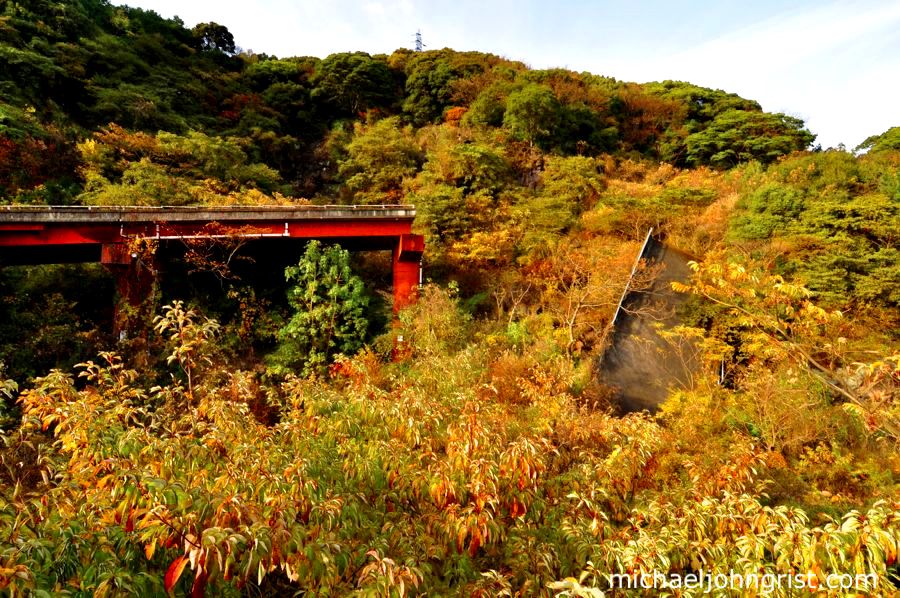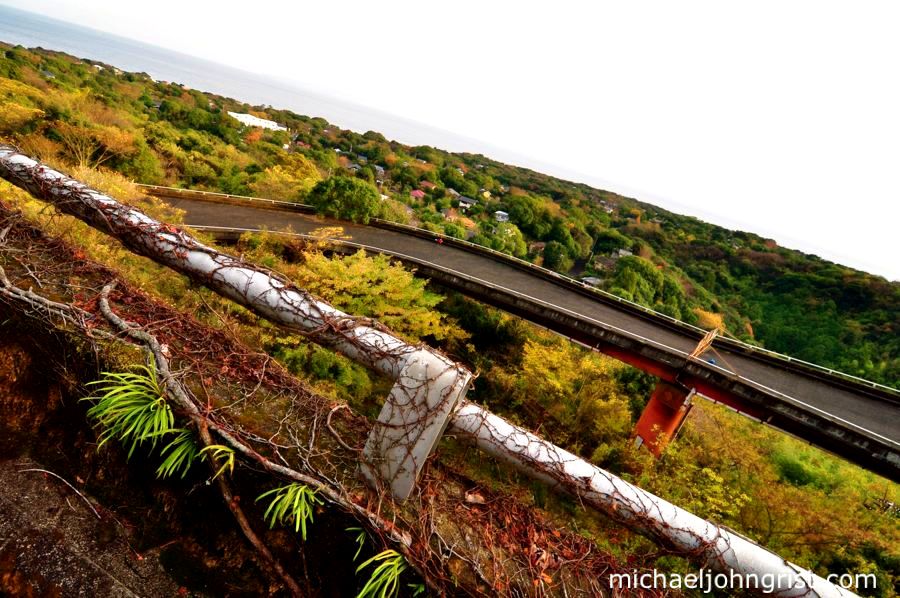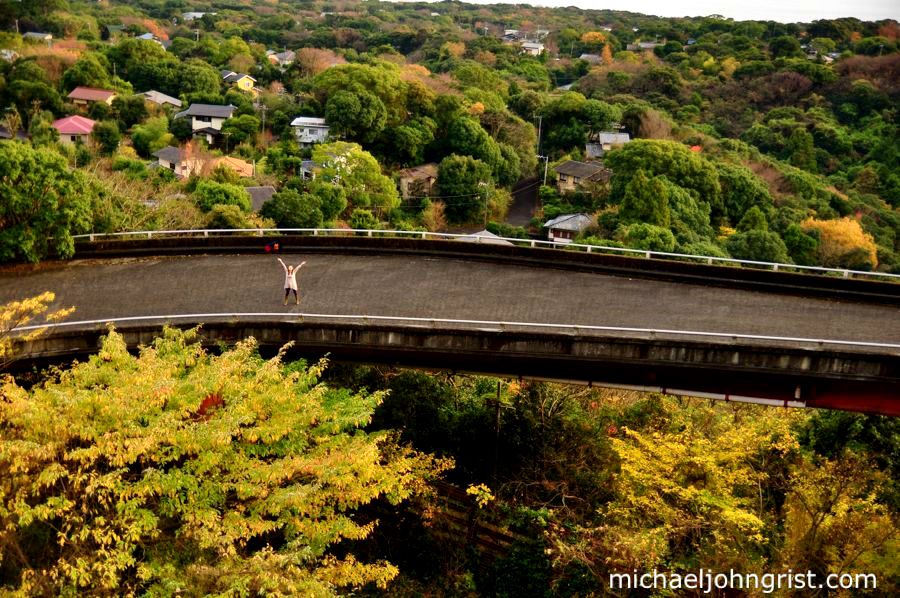It’s fairly well known that Japan’s construction industry is running rampant. There are lots of statistics about how many more roads, airports, and dams Japan has than other developed nations. The system seems to function in the stead of social safety nets in other countries; if you can’t get a job, well, the government will put you to work building more roads.
It results in a countryside covered in concrete, and thousands of rural projects that fall into dis-use, since they were never needed anyway. This is the fate awaiting them.

Apocalypse Road
I don’t know much about this road in particular. It’s pretty famous on the Japanese haikyo sites, but no one there seems to agree on who built it or what it was for. One site says construction started in the 1960’s and finished in 1973, another says it was abandoned as recently as 1997. I read elsewhere that it was a private project designed to bring traffic up to a projected onsen area in the mountains, but it seems difficult to believe any onsen company could afford the huge expense of this road, so I’m assuming it was built by the government.
I came with SY- we had to climb some fences and scrabble around in the overgrowth to get in. The road from below is strikingly huge, and so bizarre to find in the midst of a jungle. I stood on top of the road and thought of all the post-apocalypse movies I’ve seen, with their beautiful vistas of crumbling concrete and steel. There’s an excellent scene in Book of Eli where Denzel is walking beside a fallen elevated highway, and of course I thought of that.

In the shadow of the road.

It tapers overhead to landfall with the ground.

Standing within the loop.

An empty concrete hut for the troll to live in.
As a haikyoist I sometimes get asked why I think these ruins are left the way they are. The usual answer has to do with the Bubble, and ruins as toxic assets that can neither be sold or renovated. I got a good share of my information for this belief from the book Dogs and Demons by Alex Kerr, where he talks about the hey days of 80’s investment and booming real estate prices, then the crash that left the system reeling.
The Bubble answer covers all the dilapidated theme parks, hotels, and resorts we see lost in the countryside. Abandoned mines and factory towns can be explained by dwindling natural resources and a shift in population centers to the big cities. Ruins of military bases we can attribute to Imperial ambition and a strong but fading post war occupation by American forces.
That leaves us with all the country’s unnecessary infrastructure.

The fallen road section once led to a cliff, that would have had further road built atop it. Construction didn’t get that far though, whatever moorings were used were surely temporary, and the section came down.
According to the Japan Times, Japan’s obsession with road-building was seeded by the Americans over 60 years ago. After the war, they ordered up a 5-year plan designed to bolster Japan’s infrastructure and get some stimulus money circulating around the economy. It sounds a lot like Keynesian economics, similar to what several countries are doing today. As anti-stimulus forces are saying now though, the experiment seems mostly a failure. The country got hooked on infrastructure spending, and 5-year road plans became a staple of government expenditure, expanding exponentially as time went by, unhindered by any ideas of efficiency or necessity. The roads were needed to fund all the people whose livelihoods depended on building the roads.
It seems like this kind of infrastructure spending has come to take the place social welfare systems take in other countries. Without it, a large percentage of Japanese would be unemployed (up to 10% of populations in some places). All the small rural towns eking out an existence thanks to federal infrastructure spending would dry up and disappear.
Its created a voracious system that cannot stop building, a concrete addict, with no way to turn off the supply without facing some unimaginably difficult cold turkey. But that end date, let’s call it Japan’s financial apocalypse, is surely looming ever closer.

Cut off.

The fallen section is much steeper than it looks. I tried to climb up but up close it seemed almost sheer.

Beautiful fall foliage.

The piping looks a skeletal crucifixion.

Beside the bridge.

Under the bridge. Climbing over all the twisted metal rebars and dense rushes I lost my lens cap. Sad.
While it’s been building all its roads (four to five times the number of other group of 7 countries), dams (some 400 currently under construction, making it the world’s fourth largest dam-builder despite a country smaller than California), and concrete-lined rivers (with only handful of all waterways not concrete-lined), the government has been cannibalizing its own people.
According to the New York Times, Japan’s debt is $10 trillion, some 200% of GDP, and sucks up 25% of GDP for interest servicing. Compare that to America’s public debt of $13.5 trillion, at 94% of GDP. Neither country is in great condition, but Japan is obviously teetering on the edge of becoming the next Greece or Iceland. In the event that it does happen, and the world’s 3rd largest economy comes crashing to its knees, it’s the Japanese themselves who’ll be left trying to receiver money out of the hollow pit where their savings used to be. 90% of Japan’s debt is financed out of the savings of the Japanese people.
For over 60 years the government has been hovering up those savings and spewing them out as concrete. It’s an endless stimulus program of ouroborosian proportions that will surely, some day, finally swallow itself whole.

Fence preventing entry to the fallen section.

Looking out over the sea of trees.

Looking back along the path.

Over the railing and back to the loop start.

SY worships Rah.

On a grand scale.

I sit on the jagged-tooth edge and look into the abyss.

I once went somewhere.

Bright red in the nothing.

Teetering pipe railing.
I thought about all that some while I was standing on the apocalypse road. I’ve read Jared Diamond’s Collapse and watched the movies about Peak Oil. I follow the goings-on of my country’s swingeing public spending cuts, and the increases of public spending in the USA. I’m not a doom-sayer either, nor morbidly fascinated with ruins enough to want everything to be a ruin so I can dart around like a ghoul taking pictures of squalor and loss. I’m just interested in ruins, and what they tell us about ourselves.

And for fun, the two of us.
Further Reading
Japan Times: Japan’s Road to Ruin
New York Times: Japan rethinks a dam
Forex Blog: Japanese Yen and the irony of debt
See more Japanese ruins (haikyo) in the galleries:
[album id=4 template=compact]You can also see a curation of world ruins in the ruins gallery.

Comments 5
Nice Mikey – I still think you shoulda got a shot of you with your legs over the edge tho! 😉
I keep running into you and your investigations as I attempt to verify my memories and impressions of 1960s era Japan. It began with your photos of Camp Drake. How interesting your life there today must be!
Since you are the only one I kind of know who shares my sense of awe regarding the passage of time, the folly of man, and futility of force, can I ask you to put me in touch or at least recommend a contact for verifiable information, maybe even photos, of Tokyo area antiwar protests of the late ’60s? Specifically, when I was a medic serving in the 249th at Camp Drake, I believe I learned that a protest had swarmed into an underground station and LIFTED A TRAIN OFF IT’S TRACKS. Sound familiar? It astonished me at the time and I think the only reference I ever heard to it was in a radio broadcast, certainly not Armed Forces Radio. You can get back to me at if you will.
Thanks.
MK
Author
Hi Mark,
Sorry, I’m afraid I’m no use to you on that- I don’t have that kind of expertise- not even of who might know more. I was always a very ‘hands-off’ researcher for my historical info. It sounds like a really interesting story, and I’d love to hear more if you do find out more.
On the question of folly of man and futility of force- you got me, I am a big sucker for that stuff.
Good luck!
Hi Michael,
A nice post with witty observations. I would love to see that road myself. It seems there is a village in a valley behind it?
I am interested in Japanese infrastructure projects and their impact on the natural environment (speaking of dams). However, after last year’s october typhoon Ran, I realized, that the biggest modern ruin of Japan are sugi forests.
I will appreciate if you could share the coordinates of the place. Sorry if the question is unethical in the Haikyoist point of view.
Best regards,
Mikhail
Hi Michael,
I wrote a comment here yesterday asking about the location of the place, but as you mentioned, it is well covered on the japanese haikyo web. 5 minutes search showed me the location. Sorry for bothering you.
Thanks to your blog for bringing this location up to my attention.
With kindest regards,
Mikhail